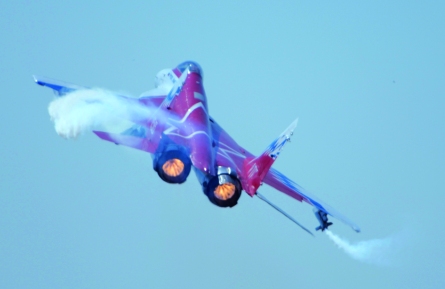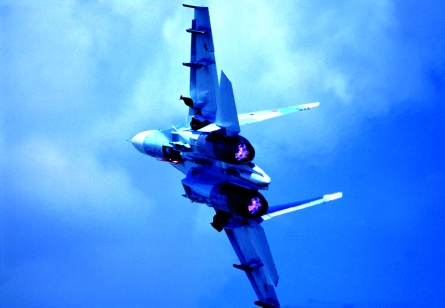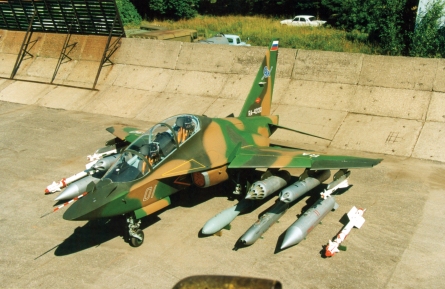Fundamental changes in the Russian engine market have resulted in a leaner, more competitive sector
Reorganisation of the Russian engine industry has left the sector leaner and fitter and notable for having secured substantial export business with China and India, as well as significant government funding for new military programmes.
In the combat-aircraft market, the surviving major players are MMPP Salyut, which divides production of AL-31F engines for Sukhoi's successful Su-27 fighter family with Ufa-based UMPO NPO Saturn, created in 2003 by the merger of Lyulka-Saturn and Rybinsk Motors and the Klimov design bureau, a member of the RSK MiG group. Ukraine's ZMKB Progress design house and Motor Sich production plant are working on supersonic trainer engines.
Salyut turnround
The Moscow-based Salyut production plant turned its fortunes around by establishing its own design house and launching a programme to improve the AL-31F, aimed at increasing reheated thrust from 26,400lb (117kN) to 29,700lb and then to 33,000lb. Salyut has bench- and flight-tested AL-31F derivatives with a larger fan, for a 20% airflow increase, and new low- and high-pressure compressors incorporating three-dimensional aerodynamics.
The Russian air force has allocated funding to complete the compressor test programme, but refused to accept the larger fan as its installation would entail major structural changes to the Su-27. Several modernised AL-31Fs are undergoing tests in Su-27 testbeds, and the air force says that it will incorporate the upgrades during major overhauls of in-service engines. Salyut-produced AL-31 powerplants are now qualified for a 1,500h time between overhauls (TBO), compared with 1,000h for UMPO-made AL-31FP thrust-vectoring engines that power Indian air force Su-30MKIs.
In December Salyut completed bench testing and received defence ministry approval for a 29,700lb-thrust AL-31FM-1 modified with upgraded compressor, digital control and the option to install an all-aspect vectoring nozzle. The engine has a service life of 1,500h and TBO of 750h and powers Sukhoi's new Su-34 fighter-bomber, which entered service at the end of 2006.
|
|---|
India's HAL has selected Saturn's AL-55I to power its HJT-36 intermediate jet trainer |
The next modernisation step will be the AL-31FM-2, which Salyut says will be finished this year. During bench testing, the engine, equipped with a new combustion chamber and full-authority digital control, reached a thrust of 31,000lb. In addition, Salyut is testing a new three-stage low-pressure compressor to be used in a further upgrade to the AL-31FM-3 with a planned thrust of 32,000lb.
Salyut hopes the AL-31FM-1 will be selected by China to modernise its fleet of Su-27/30s, for which rival NPO Saturn is proposing its new 117S engine. Under a 2005 contract worth $550 million, Salyut and UMPO are already supplying an additional 180 AL-31Fs over three years to China to power AVIC 2-built Su-27SKs (J-11s). A separate three-year, $100 million agreement covered spares for engines powering Su-27SKs and Su-30MK2s purchased from Russia and licence-built.
Salyut also developed a version of the AL-31F for single-engined fighters, and delivered 54 powerplants to AVIC 2 to equip its Chengdu J-10 prototypes. A second contract signed in 2005, worth $350 million, reportedly covers the supply of 100 AL-31FNs for the J-10, with China is expected to place an order for a further 400-500 engines.
|
|---|
Klimov's thrust-vectoring RD-33MKV is being flight tested in the MiG-29OVT |
AL-31F improvements
The Russian defence ministry, meanwhile, is funding a step-by-step improvement programme for the AL-31F, with technology insertions from the AL-41F that was developed by NPO Saturn for the defunct Mikoyan 1.44 fifth-generation fighter. Initially, Saturn, together with UMPO and Sukhoi, is developing an engine known as the 117S, with thrust increased to 32,000lb, compared with the 27,500lb rating of the Al-31F.
Rybinsk-based Saturn said earlier this year the 117S had completed bench and flight tests and, with UMPO, it plans to launch component manufacturing in 2008-10.
The 117S is being offered to power the Su-35 fighter and in February two engines were delivered to Sukhoi's Komsomolsk-on-Amur plant for installation in the first prototype. Saturn says the design tested in the 117S will be used later to develop a new engine for Sukhoi's fifth-generation fighter, designated the T-50.
RD-33 upgrades
St Petersburg-based Klimov is focusing efforts on developing and upgrading the MiG-29's RD-33 turbofan and its offspring, the RD-93 for China's FC-1 single-engined fighter. A Chinese order for 100 RD-93s worth $270 million, with options for a further 400 engines, was signed in 2005. Klimov continues to work on extending the RD-93's TBO beyond the current figure of 600h.
In January Klimov signed a $250 million deal with India to set up licence production of 120 RD-33 Series 3 engines at HAL, for both new and refurbished MiG-29s. The upgraded RD-33s are scheduled to replace 18,000lb-thrust Series 1 and 2 engines.
The current production-standard RD-33MK selected for Indian navy MiG-29K/KUBs develops 20,000lb of thrust and has a 1,000h TBO. The engine has a wider-chord fan for 6% greater airflow, full-authority digital control, a new "multi-section" no-smoke combustor and three-dimensional aerodynamics in the turbine. In 2006, RSK MiG's Chernyshev plant assembled four RD-33MKs to support flight testing of the first twin-seat MiG-29KUB, which made its maiden flight in January.
Another application for the RD-33MK powerplant is the MiG-35 that MiG plans to offer for India's multi-role combat aircraft requirement. A further option is the RD-33MKV (for vectoring), which has the same thrust rating, but which is fitted with a Klimov swivelling nozzle. This is currently being tested on a MiG-29OVT technology demonstrator.
In April last year Klimov announced that it had begun design of a new engine for the LFI next-generation lightweight fighter being developed by MiG. Although MiG has yet to define all of its requirements for the engine, Klimov has said it will be an upgrade of the RD-33 with 25,300lb thrust, vectoring nozzle and modular design.
Salyut, meanwhile, plans to co-operate with Ukraine's Motor-Sich to launch production of the Ivchenko-Progress AI-222-25 turbofan to equip Yakovlev Yak-130 combat trainers.
The Russian defence ministry has selected the baseline 5,500lb-thrust AI-222-25 to power 12 initial production trainers. Algeria has ordered 16 Yak-130s powered by the engine, which is to be assembled by Salyut in Moscow.
Chinese selection
The Al-222 has also been selected by China's AVIC 2 to power the Hongdu L-15 supersonic trainer. The L-15 will be equipped initially with the basic AI-222-25, but later with the 9,240lb-thrust, afterburning AI-222FK, the first of which was assembled at the end of 2006. Another supersonic version, the 6,600lb-thrust AI-222KFK with shortened afterburner, has no orders to date. Progress is also in the early design of a version, the AI-222-25UVT with all-aspect thrust vectoring up to 20º.
An AI-222-22 with 4,840lb thrust is offered for a modernised Aero Vodochody L-39 trainer, along with the 6,170lb-thrust AI-222-28 for the Czech company's L-159 combat trainer. The option of a Ukrainian engine will allow Aero to offer the L-159, which is now powered by a Honeywell-supplied F124, to Venezuela to avoid a US embargo.
India, meanwhile, has selected Saturn's AL-55I unreheated turbofan for the HAL HJT-36 intermediate jet trainer. The initial 4,000lb-thrust version will power the single-engined HJT-36, and a 5,000lb-thrust derivative of the twin-engined HJT-39 advanced jet trainer. Bench tests of the first prototype started in March last year and the engine is said to have completed qualification tests for the HJT-36 in December. Flight tests on an Ilyushin Il-76LL testbed are expected to start later this year.
In 2005 India signed two contacts totalling $250 million for development and licence production of 200 AL-55Is at HAL. Saturn will complete development of the engine and produce the hot section in Rybinsk while the final assembly will take place at UMPO. India will join the manufacturing process from the 100th engine. Saturn hopes to extend the agreement to cover production of 1,000 units.
In February Saturn and RSK MiG announced plans to install the AL-55I in the MiG-AT trainer being offered to India. An AL-55 with afterburner is also being proposed to power China's L-15 supersonic trainer.
|
|---|
Powering Sukhoi's fighter family, the AL-31F is the Russian engine industry's money-earner. |
Scaled-down variant
A scaled-down variant of the AL-31F, the AL-55I is intended to head a family of engines based on the same core, with thrusts from 3,800-11,000lb for non-reheated applications, 11,000-15,400lb for augmented variants and up to 15,400lb for a planned civil geared-fan engine. The Russian defence ministry is funding development of an 11,000lb-thrust variant for future unmanned aircraft applications.
Among other Russian engine manufacturers, Samara-based Kuznetsov is unlikely to survive its long-year crisis, having completed the modernisation of NK-32s powering Tupolev Tu-160 strategic bombers in April last year. The upgraded engine is said to have higher reliability and increased time between overhauls.
The first modernised Tu-160 with the improved engines is to enter service this year. Moscow-based Soyuz, formerly known as Tumansky, has virtually ended its military aeroengine business, focusing on ground applications of the R-79 engine developed in late 1980s an early 1980 90s for the now-defunct MFI fifth-generation fighter project.
|
|---|
Yakovlev Yak-130 trainers will be powered by Ivchenko-Progress AI-222-25s |
Source: Flight International



























